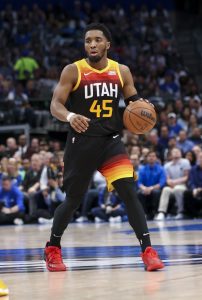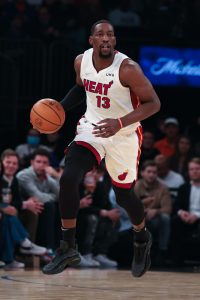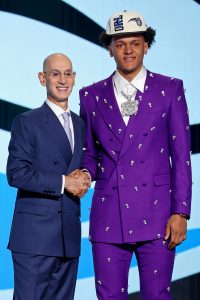A number of 2022 free agents, such as Bradley Beal and Zach LaVine, did extremely well for themselves on the open market this summer. However, many of the most lucrative contracts signed since the new league year began weren’t free agent deals at all — they were contract extensions.
Extensions, of course, don’t involve adding a new player to the roster. By extending a contract, a team ensures that a current player will remain locked up for multiple years to come. Although a contract extension may not change the club’s outlook on the court, it can have a major impact on that team’s salary cap situation for the next several seasons.
Rookie scale extensions are one form of contract extension. Former first-round picks who are entering the fourth and final year of their rookie deals are eligible to sign those up until the day before the 2022/23 regular season begins. It’s common for at least four or five players eligible for rookie scale extensions to sign them, and that number can be much higher — in 2021, there were 11 rookie scale extensions.
[RELATED: Players Eligible For Rookie Scale Extensions In 2022 Offseason]
While they used to be less common than rookie scale extensions, veteran extensions are happening more frequently these days. The league’s current Collective Bargaining Agreement expanded the rules for eligibility and created some additional incentives for star players to sign new deals before they reach free agency. During the 2021/22 league year, a total of 21 veteran extensions were signed, nearly doubling the amount of rookie scale extensions completed during that same window.
The deadline for a veteran extension for a player who isn’t in the final year of his current contract is the day before the regular season tips off. However, a player eligible for a veteran extension who is on an expiring deal can sign a new contract throughout the league year, all the way up to June 30, the day before he becomes a free agent.
Listed below are the players who have finalized contract extensions so far in 2022/23. This list, which can be found on the right-hand sidebar under “Hoops Rumors Features” on our desktop site (or on the “Features” page in our mobile menu), will be kept up to date throughout the ’22/23 league year, with more extension details added as we learn them.
Rookie scale contract extensions:
- Ja Morant (Grizzlies): Five years, maximum salary (story). Projected value of $194,300,000. Projected value can increase to $233,160,000 if Morant meets Rose Rule criteria. Includes 15% trade kicker. Starts in 2023/24.
- Darius Garland (Cavaliers): Five year, maximum salary (story). Projected value of $194,300,000. Projected value can increase to $233,160,000 if Garland meets Rose Rule criteria. Includes 15% trade kicker. Starts in 2023/24.
- Zion Williamson (Pelicans): Five years, maximum salary (story). Projected value of $194,300,000. Projected value can increase to $233,160,000 if Williamson meets Rose Rule criteria. Starts in 2023/24.
- Note: Williamson’s salary guarantees in the final four years of the extension could be adjusted downward if he doesn’t meet certain games-played thresholds.
- Note: Williamson’s salary guarantees in the final four years of the extension could be adjusted downward if he doesn’t meet certain games-played thresholds.
- Jordan Poole (Warriors): Four years, $123,000,000 (base value) (story). Includes $17MM in incentives. Starts in 2023/24.
- Tyler Herro (Heat): Four years, $120,000,000 (base value) (story). Includes $10MM in incentives. Starts in 2023/24.
- RJ Barrett (Knicks): Four years, $107,000,000 (base value) (story). Includes $13MM in incentives. Starts in 2023/24.
- De’Andre Hunter (Hawks): Four years, $90,000,000 (base value) (story). Includes $5MM in incentives. Starts in 2023/24.
- Keldon Johnson (Spurs): Four years, $74,000,000 (base value) (story). Includes $6MM in incentives. Starts in 2023/24.
- Kevin Porter Jr. (Rockets): Four years, $63,440,000 (base value) (story). Only first year is fully guaranteed. Includes fourth-year team option and $19,032,000 in incentives. Starts in 2023/24.
- Brandon Clarke (Grizzlies): Four years, $50,000,000 (base value) (story). Includes $2MM in incentives. Starts in 2023/24.
- Nassir Little (Trail Blazers): Four years, $28,000,000 (story). Starts in 2023/24.
Veteran contract extensions:
- Nikola Jokic (Nuggets): Five years, maximum salary (story). Projected value of $272,020,000. Includes fifth-year player option and 15% trade kicker. Starts in 2023/24.
- Devin Booker (Suns): Four years, maximum salary (story). Includes 10% trade kicker. Starts in 2024/25.
- Note: Booker’s starting salary in 2024/25 will be 35% of the ’24/25 salary cap.
- Karl-Anthony Towns (Timberwolves): Four years, maximum salary (story). Includes fourth-year player option. Starts in 2024/25.
- Note: Towns’ starting salary in 2024/25 will be 35% of the ’24/25 salary cap.
- Andrew Wiggins (Warriors): Four years, $109,000,002 (story). Includes fourth-year player option. Starts in 2023/24.
- Damian Lillard (Trail Blazers): Two years, maximum salary (story). Worth at least $106,552,285 and as much as $121,774,039, depending on ’25/26 salary cap figure. Starts in 2025/26.
- LeBron James (Lakers): Two years, maximum salary (story). Worth at least $97,133,373 and as much as $111,009,571, depending on ’23/24 salary cap figure. Includes second-year player option. Starts in 2023/24.
- Bogdan Bogdanovic (Hawks): Four years, $68,000,000 (story). Includes fourth-year team option. Starts in 2023/24.
- CJ McCollum (Pelicans): Two years, $64,000,000 (story). Starts in 2024/25.
- Nikola Vucevic (Bulls): Three years, $60,000,000 (story). Starts in 2023/24.
- Harrison Barnes (Kings): Three years, $54,000,000 (story). Starts in 2023/24. Includes 10% trade kicker.
- Naz Reid (Timberwolves): Three years, $41,959,296 (story). Includes third-year player option. Starts in 2023/24.
- Myles Turner (Pacers): Two years, $40,903,500 (story). Includes renegotiation ($17,096,500 added to 2022/23 salary; $58,000,000 in total new money). Includes $3MM in incentives. Extension starts in 2023/24.
- Bojan Bogdanovic (Pistons): Two years, $39,032,850 (story). Second year partially guaranteed. Starts in 2023/24.
- Maxi Kleber (Mavericks): Three years, $33,000,000 (story). Starts in 2023/24.
- Kentavious Caldwell-Pope (Nuggets): Two years, $30,145,123 (story). Includes second-year player option. Starts in 2023/24.
- Pat Connaughton (Bucks): Three years, $28,271,607 (story). Includes third-year player option. Starts in 2023/24.
- Kenrich Williams (Thunder): Four years, $27,170,000 (story). Includes fourth-year team option. Starts in 2023/24.
- Steven Adams (Grizzlies): Two years, $25,200,000 (story). Starts in 2023/24.
- Larry Nance Jr. (Pelicans): Two years, $21,580,000 (story). Starts in 2023/24.
- Al Horford (Celtics): Two years, $19,500,000 (story). Includes trade kicker (15% or $500K, whichever is lesser). Starts in 2023/24.
- Dean Wade (Cavaliers): Three years, $18,500,000 (story). Third year partially guaranteed. Starts in 2023/24.
- John Konchar (Grizzlies): Three years, $18,495,000 (story). Starts in 2024/25.
- Nick Richards (Hornets): Three years, $15,000,000 (story). Third year non-guaranteed. Starts in 2023/24.
Note: Multiple veterans, including Thaddeus Young (Raptors) and Gary Harris (Magic), signed extensions less than a week before the 2022/23 league year began. Those deals are listed in our 2021/22 extension tracker.
 They also acquired a first-round pick from the Nets in exchange for wing starter
They also acquired a first-round pick from the Nets in exchange for wing starter 
 The value of those contracts depends on where a player was drafted. This year, No. 1 overall pick
The value of those contracts depends on where a player was drafted. This year, No. 1 overall pick